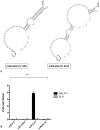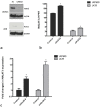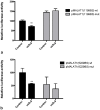microRNA-9 targets the long non-coding RNA MALAT1 for degradation in the nucleus
- PMID: 23985560
- PMCID: PMC3756333
- DOI: 10.1038/srep02535
microRNA-9 targets the long non-coding RNA MALAT1 for degradation in the nucleus
Abstract
microRNAs regulate the expression of over 60% of protein coding genes by targeting their mRNAs to AGO2-containing complexes in the cytoplasm and promoting their translational inhibition and/or degradation. There is little evidence so far for microRNA-mediated regulation of other classes of non-coding RNAs. Here we report that microRNA-9 (miR-9) regulates the expression of the Metastasis Associated Lung Adenocarcinoma Transcript 1 (MALAT-1), one of the most abundant and conserved long non-coding RNAs. Intriguingly, we find that miR-9 targets AGO2-mediated regulation of MALAT1 in the nucleus. Our findings reveal a novel direct regulatory link between two important classes of non-coding RNAs, miRs and lncRNAs, and advance our understanding of microRNA functions.
Figures




References
MeSH terms
Substances
LinkOut - more resources
Full Text Sources
Other Literature Sources
Molecular Biology Databases

